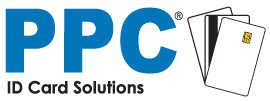MIFARE® cards offer a seamless and secure way to facilitate various applications across multiple sectors.
What are MIFARE Cards?
MIFARE cards are a type of contactless smart card widely used for their convenience and security. These cards employ RFID (Radio-Frequency Identification) technology to communicate with readers without physical contact.
MIFARE cards were introduced in 1994 by Philips, now known as NXP Semiconductors. These cards were initially developed primarily for automated fare collection in public transportation systems. Over time, their applications expanded beyond transportation to include a variety of other uses, such as access control and cashless payment systems.
MIFARE cards look like ordinary blank PVC cards, but an antenna and MIFARE chip are hidden beneath the surface. And like any other plain PVC card, they can be pre-printed with fixed designs or customised using a card printer for personalisation as an ID card or payment/transaction card like transport ticketing.
Critical Benefits of MIFARE Cards
MIFARE cards are a cheap method of providing secure contactless transactions and electronic identification, which supersedes traditional magnetic stripes, which are inherently insecure. They are a mechanical process that creates wear and tear on both cards and readers, requiring regular maintenance or replacement.
The functional benefits of MIFARE cards include secure data storage, fast and efficient transactions, and the versatility to be used in a wide range of applications. These cards incorporate advanced security measures, such as encryption, to protect personal information and transactions.
While MIFARE cards are used for their (virtually) unique serial number, they also include the capacity for secure storage of one or more “applications” that allow interaction with multiple systems without impacting the integrity of the other systems’ security—for example, access control systems and electronic transport ticketing.
The ubiquity of MIFARE technology has also led to its use in devices like modern mobile phones, which will lead to a transition, over time, from cards to devices like phones and watches.
Applications of MIFARE Cards
MIFARE cards, once mainly used in public transportation, now play a crucial role in various sectors, especially education. Thanks to their secure data storage capabilities, these cards are versatile and valuable in several areas:
Photocopier Cost Control: They help manage and monitor photocopier use, streamlining payment for copy and print services.
Library Borrowing: MIFARE cards replace traditional library cards, enabling book and resource checkouts.
Access Control: These cards control entry to various campus areas such as buildings, rooms, accommodations, IT facilities, and parking spaces. Canteen/Kiosk Transactions: Used in canteens and kiosks for cashless purchases of food, drinks, and other items. They are also implemented in vending machines.
Attendance Tracking: MIFARE cards are instrumental in recording and tracking attendance in specific locations or events, essential for managing student or employee presence.
Secure Identification During Exams: By comparing a photo on a student card against a central database, these cards reduce fraudulent ID use, ensuring exam integrity.
Computer Access and Log On: They regulate computer access, requiring users and passwords for authorised use.
Event Ticketing and Tracking: MIFARE cards are used for event ticket issuance and attendee tracking. Incorporating barcodes or RFID technology reduces the likelihood of ticket fraud.
The MIFARE Family: Different Types of Cards
The MIFARE family includes several cards, each tailored to specific needs. From the basic MIFARE Classic cards to the more advanced MIFARE DESFire series, each variant offers unique features, catering to different security and storage requirements.
There are four main families of MIFARE cards in use today. They are.
MIFARE Classic®: This family is the pioneer in the MIFARE series, operating at a frequency of 13.56 MHz with read/write capability. MIFARE Classic is widely used for intelligent ticketing applications due to its ease of use and ISO 14443 compliance. It is popular in public transport ticketing and access control systems.
MIFARE DESFire®: Designed for applications requiring higher levels of security, MIFARE DESFire cards are suitable for customers demanding robust security measures. These cards are often used in secure access control systems and multi-application smart cards, including e-payment and e-government services.
MIFARE Plus®: As an upgrade to the Classic family, MIFARE Plus offers enhanced security features. It is ideal for projects that evolve from basic to more secure systems, often used in access management and smart city services.
MIFARE Ultralight®: These cards are designed for single-use or limited-use applications where cost-effectiveness and simplicity are critical. They are typically used in event ticketing, public transport day passes, and other scenarios where a disposable or short-term use card is needed.
Security Features of MIFARE Cards
MIFARE cards are renowned for their robust security features, making them a preferred choice for applications demanding high levels of security, such as access control, payment systems, and identity verification.
The security features, including advanced encryption and robust authentication protocols, provide a comprehensive shield against common security threats. This makes them an ideal solution for applications where the security of data and transactions is paramount. As technology evolves, MIFARE cards are continually updated to counter emerging security challenges, ensuring they remain at the forefront of secure contactless technology.
Advanced Encryption Techniques
MIFARE cards utilise sophisticated encryption methods to secure the data stored on them. One of the key encryption standards employed is the AES (Advanced Encryption Standard), particularly in the higher-end MIFARE DESFire and MIFARE Plus card families. AES is a globally recognised encryption standard, renowned for its strength and efficiency in protecting sensitive data. This encryption algorithm ensures that the data exchanged between the card and the reader is thoroughly encrypted, making it nearly impossible for unauthorised parties to intercept and decipher sensitive information.
Robust Authentication Protocols
Authentication is another cornerstone of MIFARE’s security framework. The cards use a secure authentication process to establish a trusted connection between the card and the reader. This process involves a challenge-response mechanism, where the card and the reader exchange cryptographic challenges to verify each other’s identity. This mutual authentication ensures that only authorised readers can access the information on the card, thereby safeguarding against unauthorised reading or cloning of the card.
Defence Against Common Security Threats
MIFARE technology is designed to counter various common security threats:
Data Integrity: By employing encryption and secure storage, MIFARE cards ensure the data’s integrity. This means the data cannot be altered or tampered with without proper authentication.
Cloning and Counterfeiting: The unique encryption keys and authentication protocols make cloning or counterfeiting MIFARE cards difficult. Each card has a unique identifier, enhancing its security against duplication.
Eavesdropping Protection: The encrypted communication between the card and the reader provides a robust defence against eavesdropping. Even if intercepted, the data remains secure due to the high-level encryption it’s subjected to.
Replay Attacks: MIFARE cards are equipped to prevent replay attacks, where an unauthorised user attempts to retransmit intercepted data. The dynamic encryption keys and the challenge-response authentication process ensure that each transaction is unique and secure.



